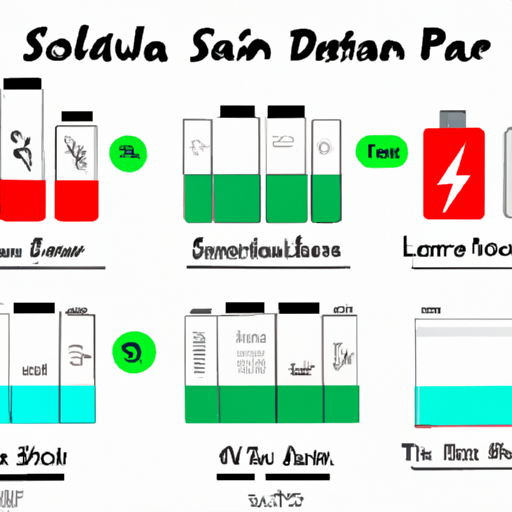Sodium batteries are a type of rechargeable battery that uses sodium ions as the charge carriers. They are a promising alternative to lithium-ion batteries due to the abundance and low cost of sodium compared to lithium. Sodium batteries have the potential to revolutionize the energy storage industry by providing a more sustainable and cost-effective solution for storing renewable energy.

1. Sodium-ion batteries: Sodium-ion batteries are the most common type of sodium battery currently being researched and developed. They operate on the same principle as lithium-ion batteries, with sodium ions moving between the cathode and anode during charging and discharging. Sodium-ion batteries have the potential to offer high energy density and long cycle life, making them suitable for a wide range of applications, including electric vehicles and grid energy storage.
2. Sodium-sulfur batteries: Sodium-sulfur batteries are a type of high-temperature battery that uses molten sodium as the anode and sulfur as the cathode. These batteries operate at temperatures of around 300-350 degrees Celsius, which allows for high energy density and fast charging and discharging rates. Sodium-sulfur batteries are particularly well-suited for grid energy storage applications, where their high energy density and long cycle life make them an attractive option for storing renewable energy.
3. Sodium-air batteries: Sodium-air batteries are a type of metal-air battery that uses sodium as the anode and oxygen from the air as the cathode. These batteries have the potential to offer high energy density and long cycle life, making them suitable for applications where lightweight and portable energy storage is required. Sodium-air batteries are still in the early stages of development, but they show promise as a potential alternative to lithium-air batteries.
4. Sodium-metal batteries: Sodium-metal batteries are a type of battery that uses metallic sodium as the anode. These batteries have the potential to offer high energy density and fast charging and discharging rates, making them suitable for applications where high power output is required. Sodium-metal batteries are still in the early stages of development, but they show promise as a potential alternative to lithium-metal batteries.
5. Sodium-organic batteries: Sodium-organic batteries are a type of battery that uses organic materials as the cathode and anode. These batteries have the potential to offer high energy density and long cycle life, making them suitable for a wide range of applications, including electric vehicles and grid energy storage. Sodium-organic batteries are still in the early stages of development, but they show promise as a potential alternative to lithium-organic batteries.
In conclusion, sodium batteries are a promising alternative to lithium-ion batteries due to their abundance and low cost. There are several key product categories of sodium batteries that are currently being developed and commercialized, including sodium-ion batteries, sodium-sulfur batteries, sodium-air batteries, sodium-metal batteries, and sodium-organic batteries. These batteries have the potential to revolutionize the energy storage industry by providing a more sustainable and cost-effective solution for storing renewable energy.
Sodium batteries are a type of rechargeable battery that uses sodium ions as the charge carriers. They are a promising alternative to lithium-ion batteries due to the abundance and low cost of sodium compared to lithium. Sodium batteries have the potential to revolutionize the energy storage industry by providing a more sustainable and cost-effective solution for storing renewable energy.

1. Sodium-ion batteries: Sodium-ion batteries are the most common type of sodium battery currently being researched and developed. They operate on the same principle as lithium-ion batteries, with sodium ions moving between the cathode and anode during charging and discharging. Sodium-ion batteries have the potential to offer high energy density and long cycle life, making them suitable for a wide range of applications, including electric vehicles and grid energy storage.
2. Sodium-sulfur batteries: Sodium-sulfur batteries are a type of high-temperature battery that uses molten sodium as the anode and sulfur as the cathode. These batteries operate at temperatures of around 300-350 degrees Celsius, which allows for high energy density and fast charging and discharging rates. Sodium-sulfur batteries are particularly well-suited for grid energy storage applications, where their high energy density and long cycle life make them an attractive option for storing renewable energy.
3. Sodium-air batteries: Sodium-air batteries are a type of metal-air battery that uses sodium as the anode and oxygen from the air as the cathode. These batteries have the potential to offer high energy density and long cycle life, making them suitable for applications where lightweight and portable energy storage is required. Sodium-air batteries are still in the early stages of development, but they show promise as a potential alternative to lithium-air batteries.
4. Sodium-metal batteries: Sodium-metal batteries are a type of battery that uses metallic sodium as the anode. These batteries have the potential to offer high energy density and fast charging and discharging rates, making them suitable for applications where high power output is required. Sodium-metal batteries are still in the early stages of development, but they show promise as a potential alternative to lithium-metal batteries.
5. Sodium-organic batteries: Sodium-organic batteries are a type of battery that uses organic materials as the cathode and anode. These batteries have the potential to offer high energy density and long cycle life, making them suitable for a wide range of applications, including electric vehicles and grid energy storage. Sodium-organic batteries are still in the early stages of development, but they show promise as a potential alternative to lithium-organic batteries.
In conclusion, sodium batteries are a promising alternative to lithium-ion batteries due to their abundance and low cost. There are several key product categories of sodium batteries that are currently being developed and commercialized, including sodium-ion batteries, sodium-sulfur batteries, sodium-air batteries, sodium-metal batteries, and sodium-organic batteries. These batteries have the potential to revolutionize the energy storage industry by providing a more sustainable and cost-effective solution for storing renewable energy.